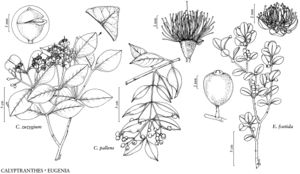Calyptranthes zuzygium
Prodr., 79. 1788.
Shrubs or trees to 12 m, glabrous throughout. Young stems terete to compressed; bark pale gray, smooth. Leaves: petiole stout, 2–4 mm, shallowly channeled; blade mostly elliptic to obovate, occasionally ovate, 4–6(–7) × 2–4 cm, midvein convex adaxially, distinctly broader proximally, lateral veins ca. 20 pairs, faint, ascending, marginal vein 1, 1–2 mm from margin, gently arching between lateral veins and margin, or with second faint marginal vein parallel to margin, base cuneate, apex obtuse to abruptly blunt-tipped, adaxial surface lustrous. Peduncles slender, 2.5–4 cm (longer than fertile portion of panicle). Inflorescences 9–20-flowered, flowers mostly in triads; panicles in pairs and laxly flowered, or sometimes 1 panicle present by abortion; bracts and bracteoles early deciduous. Pedicels (0–)1.5–5 mm. Flowers fragrant; bud obovoid, 3.5–4.5 mm; hypanthium broadly crateriform, shallowly cylindrical in fruit, 3.5–4.5 mm wide; calyptra 3.5–4.5 mm wide, apiculate; stamens 4 mm; style 5 mm. Berries bluish black, spheroid to oblate, 8–10 mm diam. Seed 5 mm diam.
Phenology: Flowering late spring–early summer.
Habitat: Subtropical hardwood hammocks.
Elevation: 0–10 m.
Distribution
Subtropical hardwood hammocks, Fla., West Indies.
Discussion
Calyptranthes zuzygium is known from the Everglades and the Florida Keys, in Miami-Dade and Monroe counties; it is listed as endangered by the state of Florida.
Selected References
None.
